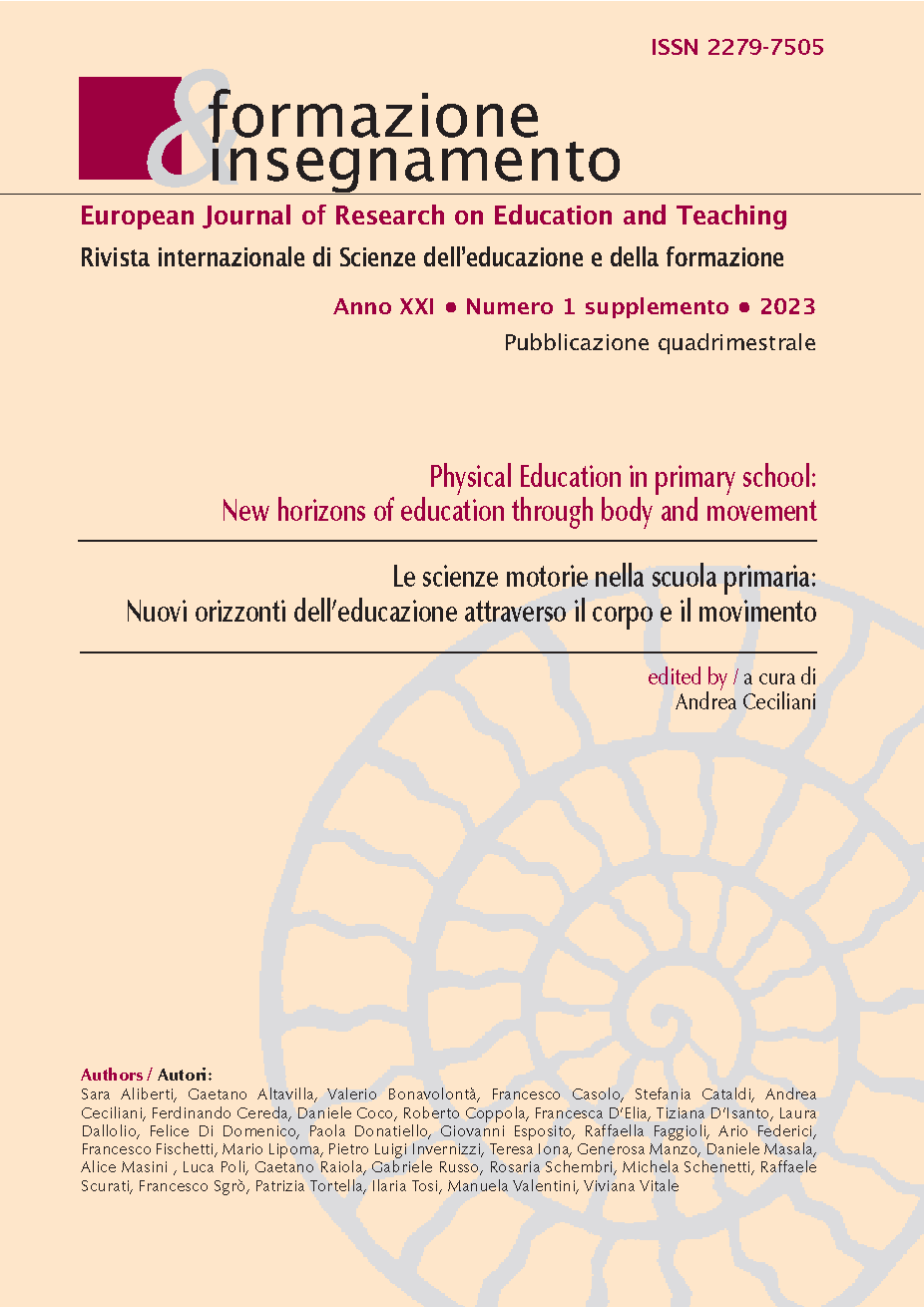The methodology of physical education
DOI:
https://doi.org/10.7346/-feis-XXI-01-23_07Keywords:
Physical education, Sport, Teaching, MethodAbstract
Physical activity’s method has been analysed and placed in the current educational landscape. The importance of its educational action on the body and mind is also reported in the context of education in general and in the school environment. The primary aim of physical education is to develop all the body and mind skills. Physical education finds its raison d'être in methodological and didactic models that make it possible to introduce sports education and actual sport. The aims of physical education must be part of those of general education and a methodological dialogue must start from these premises: from what is to be achieved through movement and subordinate the choice of the means deemed most suitable for achieving them.
References
Azzarito, L., & Harrison, L. Jr, (2008). “White men can’t jump”: Race, gender and natural athleticism. International Review for the Sociology of Sport, 43(4), 347–364. https://doi.org/10.1177/1012690208099871
Azzarito, L. (2010). Ways of Seeing the Body in Kinesiology: A Case for Visual Methodologies. Quest, 62(2), 155–170. https://doi.org/10.1080/00336297.2010.10483639
Bailey, R., Hillman, C., Arent, S., & Petitpas, A. (2013). Physical activity: an underestimated investment in human capital?. Journal of physical activity & health, 10(3), 289–308. https://doi.org/10.1123/jpah.10.3.289
Banks, M. (2001). Visual Methods in social research. London: Sage.
Biccardi, T. (2001). La comunicazione corporea. In M. Sibilio (Ed.), Il laboratorio come percorso formativo. Napoli: Esselibri.
Calidoni, P. (2000). Didattica come sapere professionale. Brescia: La Scuola.
Carraro, A. (2008). Educare al movimento. Lecce: Pensa MultiMedia.
Carraro, A., & Lanza, M. (2004). Insegnare/Apprendere in Educazione Fisica: problemi e prospettive. Roma: Armando.
Cereda, F. (2013). Teoria, tecnica e didattica del fitness. Milano: Vita e Pensiero.
Cereda, F. (2015). Attività motoria, sport e processi educativi. Tra implicazioni didattiche e aspetti pedagogici. Pedagogia e Vita, 73, 260–272.
Cereda, F. (2016). Attività Fisica e Sportiva: tra l’educazione della persona e le necessità per la salute. Formazione & insegnamento, 14(2S), 25–32. Retrieved January 31, 2023, from https://ojs.pensamultimedia.it/index.php/siref/article/view/2006
Cilia, G., Ceciliani, A., Dugnani, S., & Monti, V. (1996). L’educazione fisica. Padova: Piccin.
European Commission, & World Health Organization Regional Office for Europe. (2014). First Meeting of the European Union Physical Activity Focal Points Network rome, Italy 21-22 October 2014: Meeting Report. Copenhagen: WHO Regional Office for Europe. Retrieved January 31, 2023, from https://www.euro.who.int/__data/assets/pdf_file/0003/272676/FirstMeetingEUphysicalActivityFocalPointsNetwork.pdf
Faigenbaum, A. D., McFarland, J. E., Johnson, L., Kang, J., Bloom, J., Ratamess, N. A., & Hoffman, J. R. (2007). Preliminary evaluation of an after-school resistance training program for improving physical fitness in middle school-age boys. Perceptual and motor skills, 104(2), 407–415. https://doi.org/10.2466/pms.104.2.407-415
Gamelli, I. (2004). Pedagogia ed educazione motoria. Milano: Guerini Reprint.
Gauntlett, D., & Holzwarth, P. (2006). Creative and visual methods for exploring identities. Visual Studies, 21(1), 82–91. https://doi.org/10.1080/14725860600613261
Le Boulch, J. (1979). Verso una scienza del movimento umano. Roma: Armando.
Lipoma, M. (Ed.). (2014). Le ontologie pedagogiche dell’educazione motoria. Lecce: Pensa MultiMedia.
Lloyd, R. S., Faigenbaum, A. D., Stone, M. H., Oliver, J. L., Jeffreys, I., Moody, J. A., Brewer, C., Pierce, K. C., McCambridge, T. M., Howard, R., Herrington, L., Hainline, B., Micheli, L. J., Jaques, R., Kraemer, W. J., McBride, M. G., Best, T. M., Chu, D. A., Alvar, B. A., & Myer, G. D. (2014). Position statement on youth resistance training: the 2014 International Consensus. British journal of sports medicine, 48(7), 498–505. https://doi.org/10.1136/bjsports-2013-092952
Meinel, K. (1984). Teoria del movimento. Roma: Società Stampa Sportiva.
MIUR. (2009). “Cittadinanza e Costituzione” al via la sperimentazione nelle scuole italiane. Comunicato Stampa del 4 marzo 2009. Retrieved March 5, 2009, from https://www.istruzione.it/archivio/web/ministero/cs040309.html
MIUR. (2012). Indicazioni nazionali per il curricolo delle scuole dell'infanzia e del primo ciclo di istruzione: Regolamento e testo definitivo. MIURAOODGOS/7734. Retrieved January 31, 2023, from https://www.istruzione.it/archivio/web/istruzione/prot7734_12.html
Nordmann, L. (2007). Bildung im Sport - Bildung für Sport - Bildung durch Sport: Neue Wege einer modernen Trainerausbildung. Leistungssport, 36(5), 19–24. Retrieved January 31, 2023, from https://www.iat.uni-leipzig.de/datenbanken/iks/ls/Record/2000057
Norris, E., Shelton, N., Dunsmuir, S., Duke-Williams, O., & Stamatakis, E. (2015). Physically active lessons as physical activity and educational interventions: a systematic review of methods and results. Preventive medicine, 72, 116–125. https://doi.org/10.1016/j.ypmed.2014.12.027
Novara, G. (1962). Teoria e Metodologia delle attività motorie educative. Trapani: Chirone.
Palumbo, C., Franco, S., & Cereda, F. (2017). Motor technique and didactics: a possible alliance from an educational point of view. Education Sciences & Society, 7(2), 91–105. https://journals.francoangeli.it/index.php/ess/article/view/3948
Pesce, C., Marchetti, R., Motta, A., & Bellucci, M., (2015). Joy of moving. Movimenti e Immaginazione. Giocare con la variabilità per promuovere lo sviluppo motorio, cognitivo e del cittadino. Torgiano (PG): Calzetti e Mariucci.
Rikard, L. G., & Banville, D. (2006). High school student attitudes about physical education. Sport, Education and Society, 11(4), 385–400. https://doi.org/10.1080/13573320600924882
Sibilio, M. (2015a). Il corpo educativo. In M. Sibilio (Ed.), L’agire educativo (pp. 108–119). Brescia: La Scuola.
Sibilio, M. (2015b). La funzione orientativa della didattica semplessa. Pedagogia Oggi, 2015(1), 327–334.
Sotgiu, P., & Pellegrini, F. (1989). Attività motorie e processo educativo. Roma: Società Stampa Sportiva.
Published
How to Cite
Issue
Section
License
Copyright (c) 2023 Ferdinando Cereda

This work is licensed under a Creative Commons Attribution 4.0 International License.
Formazione & insegnamento is distributed under Attribution 4.0 International (CC BY 4.0).
For further details, please refer to our Repository & Archiving Policy, as well as our Copyright & Licensing Terms.





